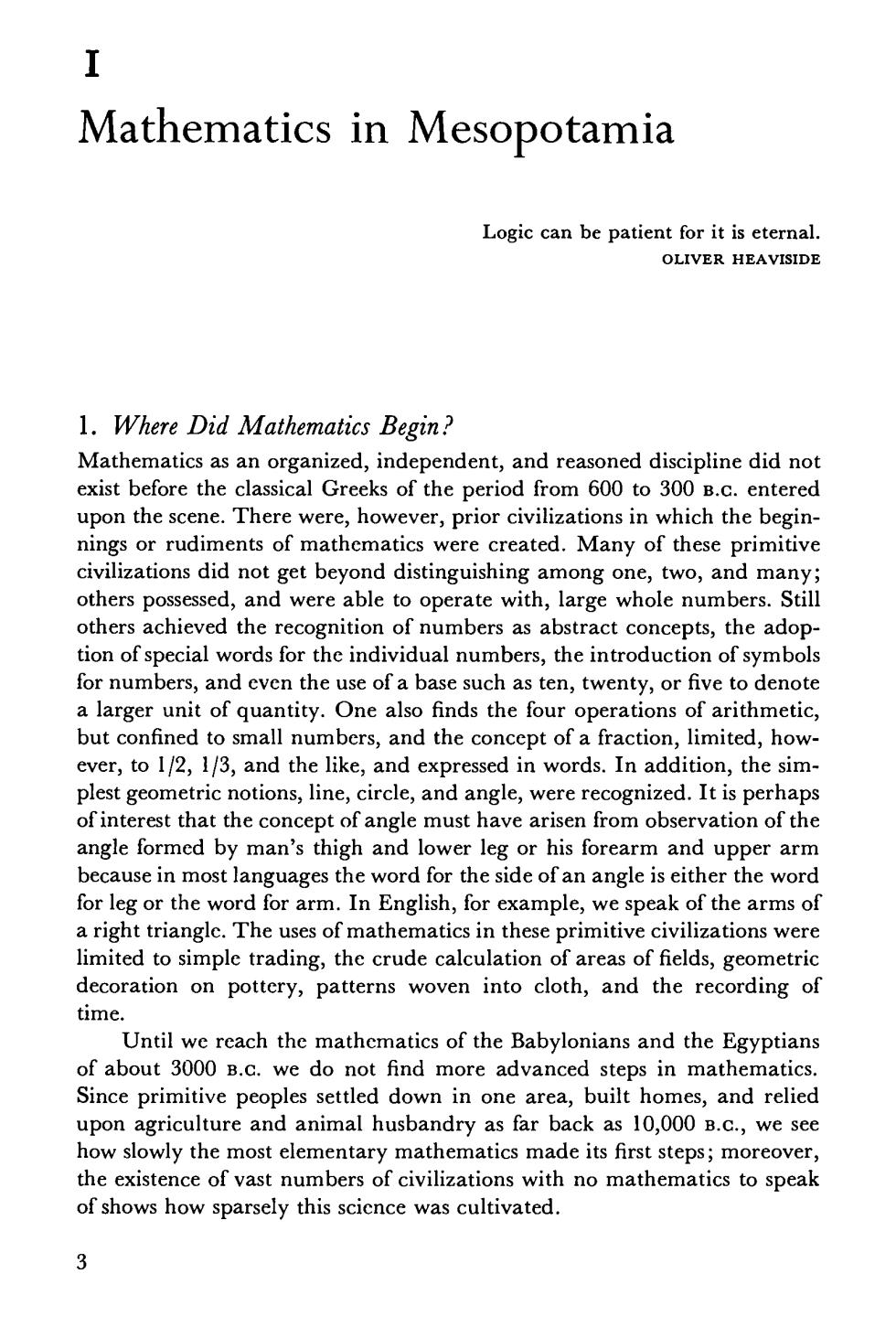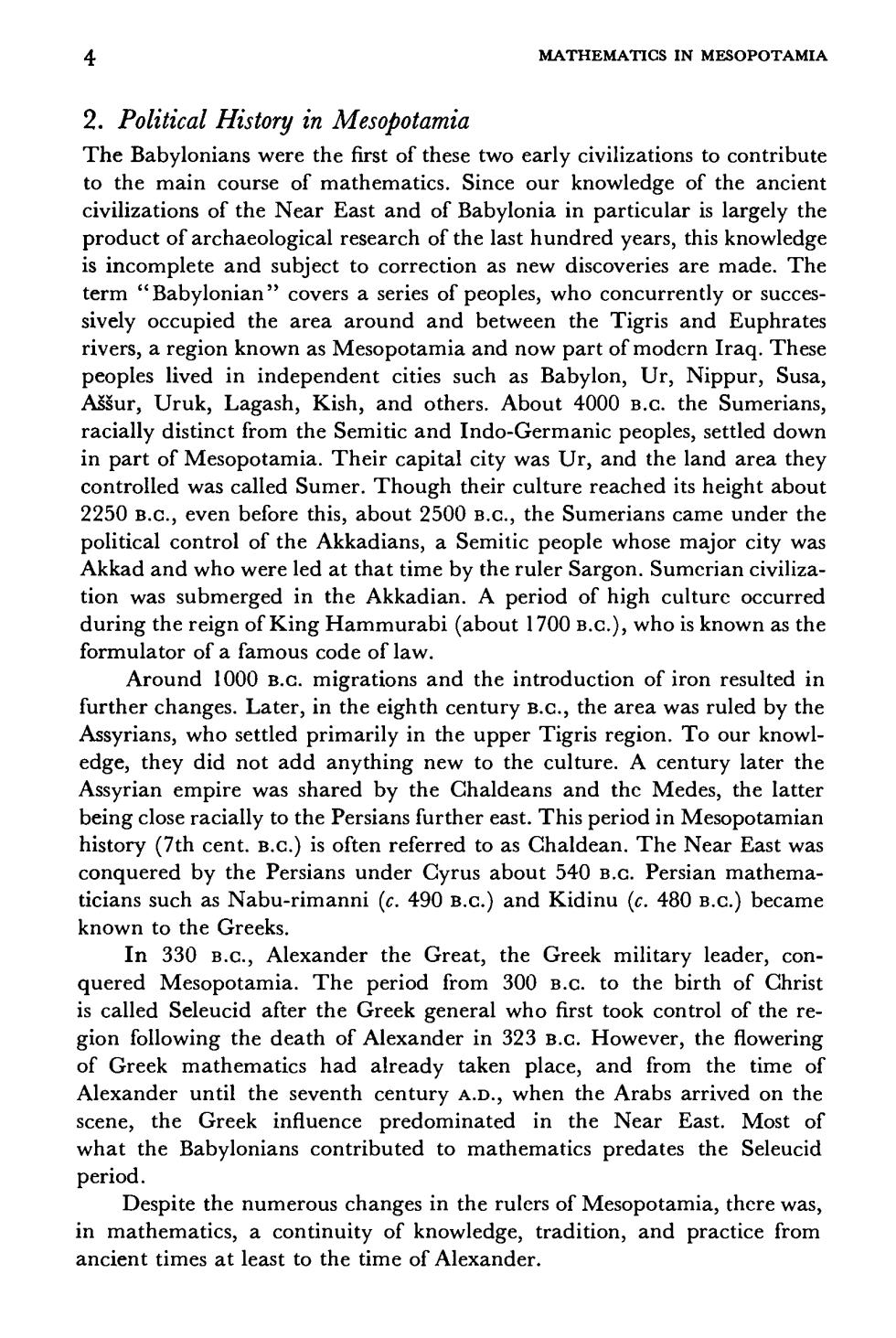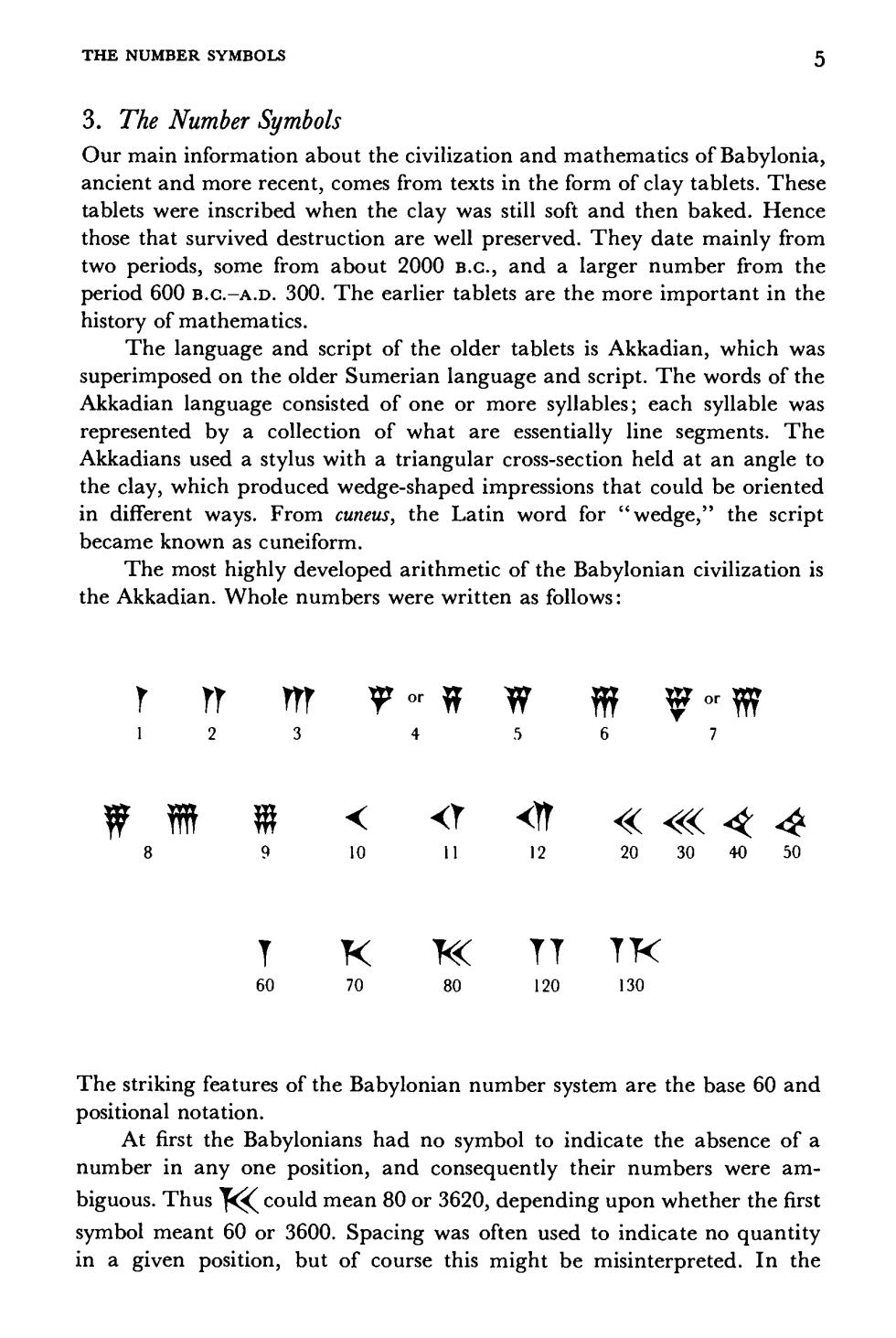
Mathematical Thought from Ancient to Modern Times

I Mathematics in Mesopotamia Logic can be patient for it is eternal. OLIVER HEAVISIDE 1.Where Did Mathematics Begin? Mathematics as an organized,independent,and reasoned discipline did not exist before the classical Greeks of the period from 600 to 300 B.c.entered upon the scene.There were,however,prior civilizations in which the begin- nings or rudiments of mathematics were created.Many of these primitive civilizations did not get beyond distinguishing among one,two,and many others possessed,and were able to operate with,large whole numbers.Still others achieved the recognition of numbers as abstract concepts,the adop- tion of special words for the individual numbers,the introduction of symbols for numbers,and even the use of a base such as ten,twenty,or five to denote a larger unit of quantity.One also finds the four operations of arithmetic, but confined to small numbers,and the concept of a fraction,limited,how- ever,to 1/2,1/3,and the like,and expressed in words.In addition,the sim- plest geometric notions,line,circle,and angle,were recognized.It is perhaps of interest that the concept of angle must have arisen from observation of the angle formed by man's thigh and lower leg or his forearm and upper arm because in most languages the word for the side of an angle is either the word for leg or the word for arm.In English,for example,we speak of the arms of a right triangle.The uses of mathematics in these primitive civilizations were limited to simple trading,the crude calculation of areas of fields,geometric decoration on pottery,patterns woven into cloth,and the recording of time. Until we reach the mathematics of the Babylonians and the Egyptians of about 3000 B.c.we do not find more advanced steps in mathematics. Since primitive peoples settled down in one area,built homes,and relied upon agriculture and animal husbandry as far back as 10,000 B.c.,we see how slowly the most elementary mathematics made its first steps;moreover. the existence of vast numbers of civilizations with no mathematics to speak of shows how sparsely this scicnce was cultivated

MATHEMATICS IN MESOPOTAMIA 2.Political History in Mesopotamia The Babylonians were the first of these two early civilizations to contribute to the main course of mathematics.Since our knowledge of the ancient civilizations of the Near East and of Babylonia in particular is largely the product of archaeological research of the last hundred years,this knowledge is incomplete and subject to correction as new discoveries are made.The term "Babylonian"covers a series of peoples,who concurrently or succes- sively occupied the area around and between the Tigris and Euphrates rivers,a region known as Mesopotamia and now part of modern Iraq.These peoples lived in independent cities such as Babylon,Ur,Nippur,Susa, Assur,Uruk,Lagash,Kish,and others.About 4000 B.c.the Sumerians, racially distinct from the Semitic and Indo-Germanic peoples,settled down in part of Mesopotamia.Their capital city was Ur,and the land area they controlled was called Sumer.Though their culture reached its height about 2250 B.c.,even before this,about 2500 B.c.,the Sumerians came under the political control of the Akkadians,a Semitic people whose major city was Akkad and who were led at that time by the ruler Sargon.Sumerian civiliza- tion was submerged in the Akkadian.A period of high culturc occurred during the reign of King Hammurabi (about 1700 B.c.),who is known as the formulator of a famous code of law Around 1000 B.c.migrations and the introduction of iron resulted in further changes.Later,in the eighth century B.c.,the area was ruled by the Assyrians,who settled primarily in the upper Tigris region.To our knowl- edge,they did not add anything new to the culture.A century later the Assyrian empire was shared by the Chaldeans and the Medes,the latter being close racially to the Persians further east.This period in Mesopotamian history (7th cent.B.c.)is often referred to as Chaldean.The Near East was conquered by the Persians under Cyrus about 540 B.c.Persian mathema- ticians such as Nabu-rimanni (c.490 B.c.)and Kidinu (c.480 B.c.)became known to the Greeks. In 330 B.c.Alexander the Great.the Greek military leader.con- quered Mesopotamia.The period from 300 B.c.to the birth of Christ is called Seleucid after the Greek general who first took control of the re- gion following the death of Alexander in 323 B.c.However,the flowering of Greek mathematics had already taken place,and from the time of Alexander until the seventh century A.D.,when the Arabs arrived on the scene,the Greek influence predominated in the Near East.Most of what the Babylonians contributed to mathematics predates the Seleucid period. Despite the numerous changes in the rulers of Mesopotamia,there was, in mathematics,a continuity of knowledge,tradition,and practice from ancient times at least to the time of Alexander

THE NUMBER SYMBOLS 3.The Number Symbols Our main information about the civilization and mathematics of Babylonia, ancient and more recent,comes from texts in the form of clay tablets.These tablets were inscribed when the clay was still soft and then baked.Hence those that survived destruction are well preserved.They date mainly from two periods,some from about 2000 B.c.,and a larger number from the period 600 B.C.-A.D.300.The earlier tablets are the more important in the history of mathematics. The language and script of the older tablets is Akkadian,which was superimposed on the older Sumerian language and script.The words of the Akkadian language consisted of one or more syllables;each syllable was represented by a collection of what are essentially line segments.The Akkadians used a stylus with a triangular cross-section held at an angle to the clay,which produced wedge-shaped impressions that could be oriented in different ways.From cuneus,the Latin word for "wedge,"the script became known as cuneiform. The most highly developed arithmetic of the Babylonian civilization is the Akkadian.Whole numbers were written as follows: 中or许冲所的o洲 斑《(价 《《冬 10 11 12 20304050 《TTTK 60 70 80 120 130 The striking features of the Babylonian number system are the base 60 and positional notation. At first the Babylonians had no symbol to indicate the absence of a number in any one position,and consequently their numbers were am- biguous.Thus could mean 80 or 3620,depending upon whether the first symbol meant 60 or 3600.Spacing was often used to indicate no quantity in a given position,but of course this might be misinterpreted.In the

6 MATHEMATICS IN MESOPOTAMIA Seleucid period a special separation symbol was introduced to indicate the absence of a number.Thus 1-60*+0-60 +4 =3604.However, even in this period no symbol was used to indicate the absence of a quan- tity at the right-hand end as in our 20.In both periods the content had to be relied upon to indicate the precise value of the entire number. The Babylonians used positional notation to represent fractions also.Thus intended as a fraction meant 20/60 and,intended as a fraction, could be 21/60 or 20/60 1/602.The ambiguity in their number system is therefore even greater than previously indicated. A few fractions had special symbols.Thus one finds: These special fractions,1/2,1/3,and 2/3,were to the Babylonians"wholes," in the sense of measures of quantities,and not a division of unity into parts, though they arose as measures of quantity having these respective relations to another quantity.Thus we might write 10 cents as 1/10 in relation to the dollar but think of the 1/10 as a unit in itself. Actually the Babylonians did not use base 60 exclusively.Sometimes the years were written 2 me 25,where me stood for hundred-in our symbols,225. Also lfmu was used for 1000,generally in nonmathematical texts,though it occurs even in mathematical texts of the Seleucid period.Sometimes 10 and 60 were mixed,as in 2 me 1,10,which means 2 x 100 +1 x 60 +10 or 270.Mixed systems involving units of 60,24,12,10,6,and 2 were used for dates,areas,measures of weight,and coinage,just as we use 12 for hours,60 for minutes and seconds,12 for inches,and 10 for ordinary counting.The Babylonian systems,like ours,were a composite of many historical and regional customs.However,in the mathematical and astronomical texts they did use base 60 quite consistently. We do not know definitely how base 60 came to be used.The suggestion may have come from the systems of weight measures.Suppose we have a system of weight measures with values in it having the ratios 1/2,1/3,2/3,1,10. Now suppose there is another system with a different unit but the same ratios,and political or social forces compel the fusing of the two systems.(We have meters and yards,for example.)If the larger unit were 60 times the smaller,then 1/2,1/3,and 2/3 of the larger unit would be integral multiples of the smaller one.Thus the larger unit might have been adopted because it was so convenient. As to the origin of positional notation,there are two likely explanations. In an older scheme of writing numbers I multiplied by 60 was written with a larger than the same symbol for 1.When the writing was simplified the larger was reduced in size but kept in the usual place for 60.Hence position